Le canon antichar PAK 38
English Translation
Je remercie Massimo Bartoli pour les photos (citadelle de Belgrade )
 |
L'apparition des chars bouleversa les données stratégiques du champ de bataille. L’apparition de ces engins développés par les Anglais et les Français dans le plus grand secret entraîna une riposte rapide de la part des Allemands après un moment de flottement il est vrai. La course de l'obus et de la cuirasse commença. En effet pour percer le char il fallait concevoir un projectile plus puissant. Pour se protéger de ce projectile qu'il fallait concevoir une cuirasse plus résistante et ainsi de suite.De ce fait les Allemands développèrent un canon antichar PanzerAbwehrKanone en clair canon antichar en abrégé PAK. Le calibre se développa pour atteindre en 1945 le calibre de 128 mm.
Le canon qui nous intéresse est le PAK38/ 50 mm.
Jusqu'à 1937 les Allemands ne possédaient que des canons antichars peu puissants. Le PAK 35/36 de 37 mm. Pour le remplacer Rheinmetal développe un PAK d'un calibre de 50 mm. Ce canon développé à compter de 1938 ne put être toutefois livré aux unités qu'à la mi 1940.
Donc les premières campagnes de Pologne et France se font sans ce canon.
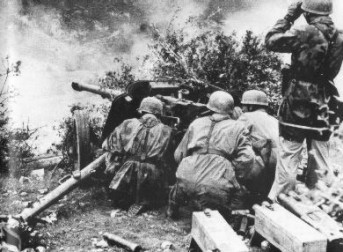 |
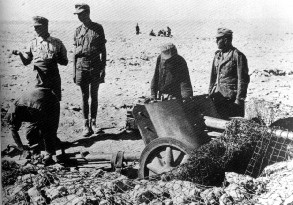 |
| PaK servi par des Parachutistes (Internet ) |
Pak servi par le DAK (internet ) |
Son premier emploi de masse eut lieu lors de l'opération Barbarossa où il utilisa une munition au noyau de tungstène (AP 40). Munition mise au point suite aux découvertes faites dans les arsenaux tchèques ou polonais. Le noyau confère au projectile un pouvoir de perforation plus important Ce canon arriva à point nommé pour s'opposer efficacement au premier T 34/76.
Ce canon a servi jusqu'à la fin de la guerre et fut aussi monté sur divers châssis d'engins chenillés.,comme le 5cm PaK 38 (Sf) auf leichter Selbstfahrlafette, le SdKfz 250 et le 5cm Pak 38 auf PzKpfw II nA.
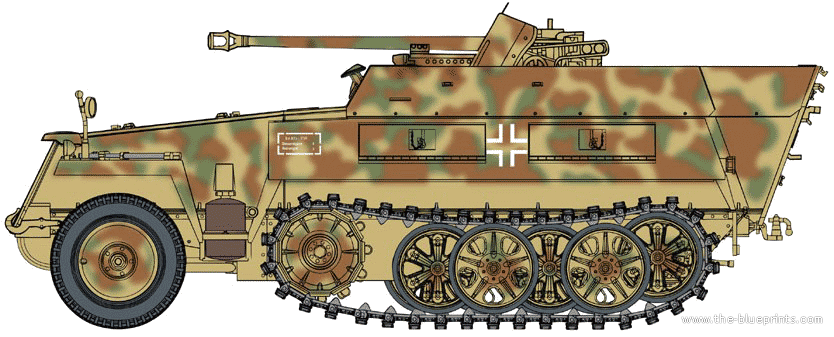 |
Il se présentait avec un bouclier incurvé, des roues en acier, et un affût à flèche ouvrant. L'affût était fait en alliage léger mais il était très solide et très maniable. Le tube était équipé de frein de bouche et une petite roulette sous l'affût permettait la manipulation aisée de l'ensemble. Un canon de ce type alimenté en automatique fut même monté sur des divers avions Me 262 et He 129. Bordkanone 5 Certaines pièces furent aussi montées sur le mur de l'Atlantique., et il servit de base pour la construction du canon anti aérien 5cm FlaK 214
.jpg) |
Munitions
Pzgr Patr 38: percuteur Bd Z 5103, poids obus 2.05kg, poids coup complet 4.13kg. Charge propulsive 882gm de Digl R P.
Pzgr Patr 38 umg: : percuteur 5103; similaire au précédent mais avec une tête perforante pour percer les nouveaux blindages.
PAK 38 Pzgr 40: poids de l obus 0.85kg; avec un noyau de tungstène et 688 gs de charge propulsive.
Sprgr Patr PAK38: percuteur AZ39; , poids obus 1.78kg; projectile standard HE à usage anti personnel. charge propulsive 280gm de Gudol R P.
Steilgranate 42: percuteur AZ5075; poids coup complet 8.20kg; HEAT charge creuse poids obus 2.33kg de cyclonite TNT; pouvait percer 180mm de blindage à 150m.
Caractéristiques PAK 38 calibre 50
Longueur 3.187 m Longueur du tube 2.461m
Largeur 2,389 m
Poids ordre de route 1.062 Kgs batterie 1000 Kgs
Pointage 65° (-8° de +27°)
Vo/munitions 835m/s pour l’AP 40
1180m/s perforant
550 m/S explosif
Portée maximale explosif 2.650m
Autres Photoscopes (Others Walk Arounds) 1 2 3 4
.
The appearance of tanks upset the strategic data of the battlefield. The appearance of these vehicles developed by the British and French in the greatest secrecy led to a rapid response from the Germans after a moment of hesitation, it is true.
The race betwee the shells and the breastplate began. Indeed for penetrating tank should design a projectile more powerful. To protect this projectile need to develop a more resistant armour etc etc .So Germans developed an antitank gun in plain PanzerAbwehrKanone antitank gun abbreviated PAK. The caliber was developed to reach in 1945 the caliber of 128 mm.
The canon that interests us is the PAK38 / 50 mm.
Until 1937 the Germans were seen to possess anti-tank guns not powerful. The PAK 35/36 to 37 mm. To replace Rheinmetal has developed a PAK with a calibre of 50 mm. This cannon developed beginning in 1938, however, could not be delivered to units until mid 1940.
So the first campaigns Poland and France are without this cannon.
 |
 |
| |
|
His first mass campaign took place during Operation Barbarossa where he used a bullet with a core of tungsten (PA 40).a munition developed following the discoveries made in the arsenals Czech or Polish.
The core gives a largest power of perforation at the gun This came at the right time to mount an effective challenge to the first 34/76 T.
This gun was used until the end of the war and was also fitted to a variety of tracked chassis. installed on many armoured vehicles as 5cm PaK 38 (Sf) auf leichter Selbstfahrlafette, SdKfz 250 and 5cm Pak PzKpfw II auf 38 nA.
 |
It was presented with a shield curved steel wheels, and a lookout jib opening. The mount was made in light alloy, but it was very solid and very handy. The tube was fitted brake mouth and a small wheel under the lookout allow easy manipulation of the whole.
A barrel of this type supplied with automatic was even mounted on various aircraft Me He 129 and 262. Bordkanone 5 Some parts were also mounted on the Atlantic Wall,and it served as the basis for the construction of the air cannon anti 5cm FlaK 214.
.jpg) |
Munitions
Pzgr Patr 38: fuse Bd Z 5103,sheild weight 2.05kg, weight of the complete shield 4.13kg.
Propulsive charg 882gm de Digl R P.
Pzgr Patr 38 umg: fuse 5103; like the Pzgr Patr 38 but with a new Head war for better anti tank performance.
PAK 38 Pzgr 40: sheild weight 0.85kg; avec un noyau de tungsten Propulsive charg 688 grs
Sprgr Patr PAK38: fuse AZ39; , shield weight 1.78kg; projectile standard HE anti personal. Propulsive charg 280gm de Gudol R P.
Steilgranate 42: fuse AZ5075; weight of the complete shield 8.20kg; HEAT shield weight 2.33kg de cyclonit TNT; he can pierce 180mm armour at 150m.
Technical data
PAK 38 calibre 50
Lenght 3.187 m (gun only 2.461m)
Width 2,389 m
Weigth 1.062 Kgs in Battery 1000 Kgs
Pointage 65° (-8° de +27°)
Vo/munitions 835m/s pour l’AP 40
1180m/s HEAT
550 m/S HE
Range HE maxf 2.650m






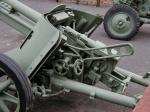
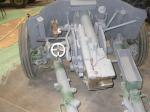
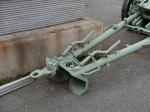
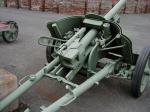
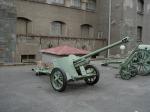



.jpg)